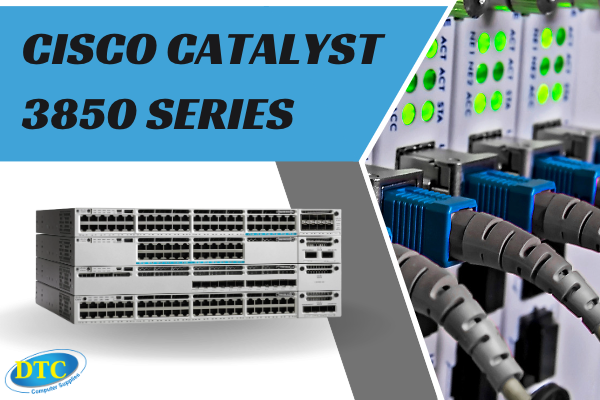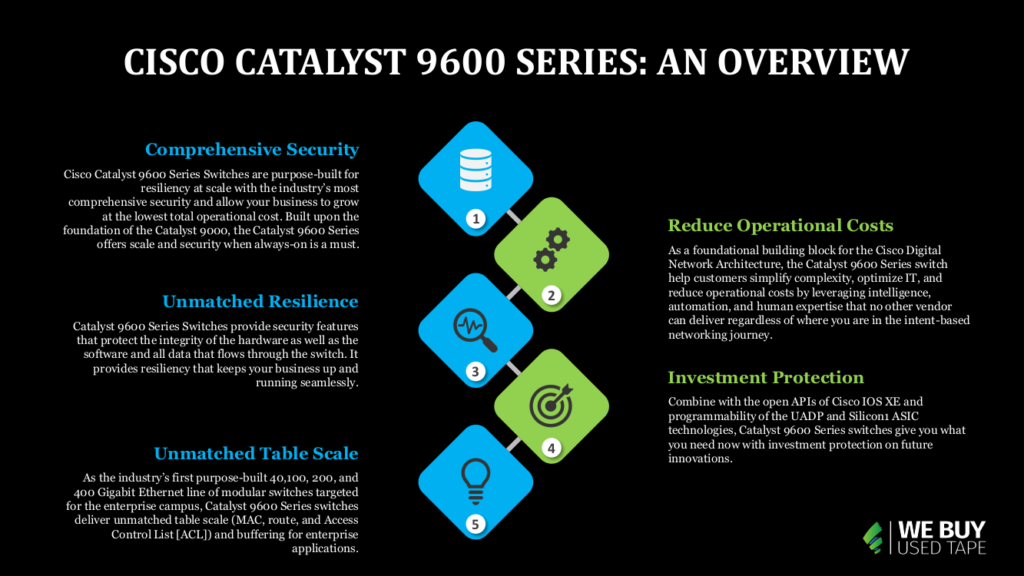- Buy Data Tape & Storage Media
- Sell Your IT Assets
- Sell Your Storage Media
- Services
- About Us
- Submit
- Log In
A network switch is a device that helps connect computers or other devices on a network by providing a central point of connection. Switches can be used to create different types of networks, including local area networks (LANs) and wide area networks (WANs).
A networking switch is a device that connects various devices on a computer network by using packet switching to receive, process, and forward data to the destination device. Switches operate at Layer 2 of the OSI model.
What are the 4 types of networking switches?
There are four types of networking switches: Layer 2, Layer 3, Multilayer, and Virtual.
Layer 2 switches are the most basic type of switch and are commonly used in small networks. They operate at the data link layer (Layer 2) of the OSI model and can only switch traffic between devices that are on the same network.
Layer 3 switches are more advanced than Layer 2 switches and can perform routing functions in addition to switching. They operate at the network layer (Layer 3) of the OSI model and can switch traffic between devices that are on different networks.
Multilayer switches are the most advanced type of switch and can perform both switching and routing functions. They operate at all layers of the OSI model and can switch traffic between devices that are on different networks.
Virtual switches are software-based switches that run on a virtual machine (VM). They offer many benefits over physical switches, including flexibility, scalability, and lower cost.

What is the difference between a hub and a switch?
A hub and a switch both provide a way to connect multiple devices on a network. The main difference between the two is that a switch provides dedicated bandwidth to each connected device, while a hub merely broadcasts data from one device to all other connected devices. This means that if you have four devices connected to a switch, each device has its dedicated connection and can theoretically achieve speeds up to the maximum bandwidth of the switch. If you have four devices connected to a hub, however, they must share the bandwidth of the single connection, meaning that the overall speed will be slower.
Why is a switch better than a hub?
A switch is a computer networking device that allows for the connection of multiple devices on a single network. A hub, on the other hand, is a device that simply allows for the connection of multiple devices on a single network. While both switches and hubs serve the same basic purpose, there are several reasons why switches are generally considered to be superior to hubs.
One of the primary reasons why switches are better than hubs is that they offer significantly more bandwidth than hubs. When multiple devices are connected to a hub, they must share the hub’s limited bandwidth. This can often lead to bottlenecks and slow speeds. Switches, on the other hand, offer each connected device its dedicated bandwidth. This ensures that each device can operate at its maximum speed without being hindered by other devices on the network.
In addition to offering more bandwidth, switches also offer better security than hubs. When multiple devices are connected to a hub, they can all see each others’ data packets. This can be a serious security risk, as it allows potential attackers to intercept and read sensitive information. Switches, on the other hand, use something called “packet switching” which only allows each device to see the data packets that are intended for it. This helps to protect sensitive data from being intercepted by unauthorized users.

Cisco Catalyst 9600 Series: An overview
Cisco Catalyst 9600 Series Switches are purpose-built for resiliency at scale with the industry’s most comprehensive security and allow your business to grow at the lowest total operational cost. Built upon the foundation of the Catalyst 9000, the Catalyst 9600 Series offers scale and security when always-on is a must.
As a foundational building block for the Cisco Digital Network Architecture, the Catalyst 9600 Series switch help customers simplify complexity, optimize IT, and reduce operational costs by leveraging intelligence, automation, and human expertise that no other vendor can deliver regardless of where you are in the intent-based networking journey.
Catalyst 9600 Series Switches provide security features that protect the integrity of the hardware as well as the software and all data that flows through the switch. It provides resiliency that keeps your business up and running seamlessly. Combine with the open APIs of Cisco IOS XE and programmability of the UADP and Silicon1 ASIC technologies, Catalyst 9600 Series switches give you what you need now with investment protection on future innovations.
As the industry’s first purpose-built 40,100, 200, and 400 Gigabit Ethernet line of modular switches targeted for the enterprise campus, Catalyst 9600 Series switches deliver unmatched table scale (MAC, route, and Access Control List [ACL]) and buffering for enterprise applications. The Cisco Catalyst 9606R chassis is hardware ready to support a wired switching capacity of up to 25.6 Tbps, with up to 6.4 Tbps of bandwidth per slot.
Cisco Catalyst 9600 Series switches support granular port densities that fit diverse campus needs, including nonblocking 40, 100, 200, and 400 Gigabit Ethernet (GE) Quad Small Form Factor Double Density (QSFP-DD), 40 and 100 Gigabit Ethernet (GE) Quad Small Form-Factor Pluggable (QSFP+, QSFP28); 1, 10, 25, and 50 GE Small Form-Factor Pluggable Plus (SFP, SFP+, SFP28, SFP56); 10G Multigigabit Ethernet (GE) (10G/5G/2.5G/1G/100M/10M) RJ45 copper ports.
The switches also support advanced routing and infrastructure services (such as Multiprotocol Label Switching [MPLS] Layer 2 and Layer 3 VPNs, Multicast VPN [MVPN], and Network Address Translation [NAT]); Cisco Software-Defined Access capabilities (such as a host tracking database, cross-domain connectivity, and VPN Routing and Forwarding [VRF]-aware Locator/ID Separation Protocol [LISP]); and network system virtualization with Cisco StackWise virtual technology that are critical for their placement in the campus core.

The Cisco Catalyst 9600 Series also supports foundational high-availability capabilities such as patching, Cisco Nonstop Forwarding with Stateful Switchover (NSF/SSO), redundant platinum-rated (2KW) or titanium-rated (3KW) power supplies, and fans, while supporting a wide array of optics.
● Hardware ready to support up to 25.6 Tbps in wired switching capacity, with up to 6.4 Tbps bandwidth per slot.
● 25.6 Tbps wired switching capacity unleashed with Cisco Catalyst 9600 Series Supervisor Engine 2. Up to 9.6 Tbps in wired switching capacity, with 3 Bpps of forwarding performance with the Cisco Catalyst 9600 Series Supervisor Engine 1.
● Capacity of up to 32 ports of 400G Gigabit Ethernet QSFP-DD ports with the Cisco Catalyst 9600 Series Supervisor Engine 2. Upto 8 non-blocking 400 Gigabit Ethernet QSFP-DD ports supported with current generation Line Cards.
● Up to 48 nonblocking 100 Gigabit Ethernet QSPF28 ports with the Cisco Catalyst 9600 Series Supervisor Engine 1, and up to 128 nonblocking 100 Gigabit Ethernet QSPF28 ports with the Cisco Catalyst 9600 Series Supervisor Engine 2.
● Up to 128 nonblocking 40 Gigabit Ethernet QSPF28 ports with the Cisco Catalyst 9600 Series Supervisor Engine 2 and up to 96 nonblocking 40 Gigabit Ethernet QSFP+ ports with the Cisco Catalyst 9600 Series Supervisor Engine 1.
● Up to 256 nonblocking 50G/25G/10G Gigabit Ethernet QSPF56 ports with the Cisco Catalyst 9600 Series Supervisor Engine 2 and up to 192 nonblocking 25 Gigabit Ethernet /10 Gigabit Ethernet SFP28/SFP+ ports with the Cisco Catalyst 9600 Series Supervisor Engine 1.
● Up to 192 non-blocking 10G multigigabit (10 Gigabit Ethernet / 5 Gigabit Ethernet / 2.5 Gigabit Ethernet / 1 Gigabit Ethernet / 100 Megabit / 10 Megabit) RJ45 copper ports with the Cisco Catalyst 9600 Series Supervisor Engine 1. Supervisor Engine 2 only supports speeds at and above 10 Gbps.
● Platinum-rated (2KW) or titanium-rated (3KW) AC power supplies.
● Platinum-rated (2KW) DC power supplies.
Conclusion
The Cisco Catalyst 9600 Series is an ideal choice for those looking to bring a powerful and reliable networking solution into their organization. With its ability to scale up as needed, it can accommodate growing data needs while also providing optimal performance, security, and resiliency. For organizations that demand cutting-edge technology and advanced features, the Cisco Catalyst 9600 Series is a perfect choice. It offers superior reliability and performance that will ensure your network stays up and running regardless of the size or complexity of your specific environment.

